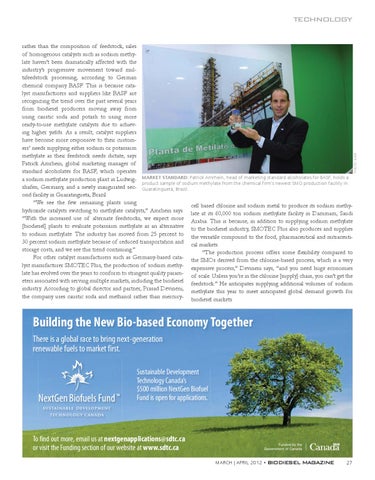rather than the composition of feedstock, sales of homogenous catalysts such as sodium methylate haven’t been dramatically affected with the industry’s progressive movement toward multifeedstock processing, according to German chemical company BASF. This is because catalyst manufacturers and suppliers like BASF are recognizing the trend over the past several years from biodiesel producers moving away from using caustic soda and potash to using more ready-to-use methylate catalysts due to achieving higher yields. As a result, catalyst suppliers have become more responsive to their customers’ needs supplying either sodium or potassium methylate as their feedstock needs dictate, says Patrick Amrhein, global marketing manager of standard alcoholates for BASF, which operates a sodium methylate production plant in Ludwig- MARKET STANDARD: Patrick Amrhein, head of marketing standard alcoholates for BASF, holds a product sample of sodium methylate from the chemical firm's newest SMO production facility in shafen, Germany, and a newly inaugurated sec- Guaratinguetá, Brazil. ond facility in Guaratingueta, Brazil. “We see the few remaining plants using cell based chlorine and sodium metal to produce its sodium methyhydroxide catalysts switching to methylate catalysts,” Amrhein says. late at its 60,000 ton sodium methylate facility in Dammam, Saudi “With the increased use of alternate feedstocks, we expect more Arabia. This is because, in addition to supplying sodium methylate [biodiesel] plants to evaluate potassium methylate as an alternative to the biodiesel industry, SMOTEC Plus also produces and supplies to sodium methylate. The industry has moved from 25 percent to the versatile compound to the food, pharmaceutical and nutraceuti30 percent sodium methylate because of reduced transportation and cal markets. storage costs, and we see this trend continuing.” “The production process offers some flexibility compared to For other catalyst manufacturers such as Germany-based cata- the SMOs derived from the chlorine-based process, which is a very lyst manufacturer SMOTEC Plus, the production of sodium methy- expensive process,” Devineni says, “and you need huge economies late has evolved over the years to conform to stringent quality param- of scale. Unless you’re in the chlorine [supply] chain, you can’t get the eters associated with serving multiple markets, including the biodiesel feedstock.” He anticipates supplying additional volumes of sodium industry. According to global director and partner, Prasad Devineni, methylate this year to meet anticipated global demand growth for the company uses caustic soda and methanol rather than mercury- biodiesel markets.
Building the New Bio-based Economy Together There is a global race to bring next-generation renewable fuels to market first. Sustainable Development Technology Canada’s $500 million NextGen Biofuel Fund is open for applications.
To find out more, email us at nextgenapplications@sdtc.ca or visit the Funding section of our website at www.sdtc.ca MARCH | APRIL 2012
z
BIODIESEL MAGAZINE
27
PHOTO: BASF
TECHNOLOGY
